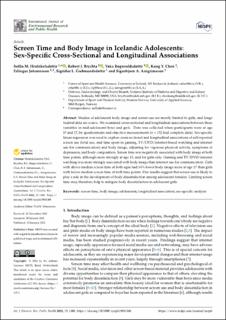| dc.contributor.author | Hrafnkelsdottir, Soffia M | |
| dc.contributor.author | Brychta, Robert J | |
| dc.contributor.author | Rognvaldsdottir, Vaka | |
| dc.contributor.author | Chen, Kong Y. | |
| dc.contributor.author | Johannsson, Erlingur | |
| dc.contributor.author | Gudmundsdottir, Sigridur Lara | |
| dc.contributor.author | Arngrimsson, Sigurbjorn Arni | |
| dc.date.accessioned | 2022-02-16T13:46:08Z | |
| dc.date.available | 2022-02-16T13:46:08Z | |
| dc.date.created | 2022-01-31T07:58:38Z | |
| dc.date.issued | 2022 | |
| dc.identifier.citation | Hrafnkelsdottir, S. M., Brychta, R. J., Rognvaldsdottir, V., Chen, K. Y., Johannsson, E., Guðmundsdottir, S. L., & Arngrimsson, S. A. (2022). Screen Time and Body Image in Icelandic Adolescents: Sex-Specific Cross-Sectional and Longitudinal Associations. International Journal of Environmental Research and Public Health, 19(3):1308. | en_US |
| dc.identifier.issn | 1661-7827 | |
| dc.identifier.uri | https://hdl.handle.net/11250/2979431 | |
| dc.description.abstract | Studies of adolescent body image and screen use are mostly limited to girls, and longitudinal data are scarce. We examined cross-sectional and longitudinal associations between these variables in mid-adolescent boys and girls. Data was collected when participants were at age 15 and 17, by questionnaire and objective measurements (n = 152 had complete data). Sex-specific linear regression was used to explore cross-sectional and longitudinal associations of self-reported screen use (total use, and time spent in gaming, TV/DVD/internet-based watching and internet use for communication) and body image, adjusting for vigorous physical activity, symptoms of depression, and body composition. Screen time was negatively associated with body image at both time points, although more strongly at age 15, and for girls only. Gaming and TV/DVD/internet watching was more strongly associated with body image than internet use for communication. Girls with above median screen time at both ages had 14% lower body image score at age 17 than girls with below median screen time at both time points. Our results suggest that screen use is likely to play a role in the development of body dissatisfaction among adolescent females. Limiting screen time may, therefore, help to mitigate body dissatisfaction in adolescent girls. | en_US |
| dc.language.iso | eng | en_US |
| dc.publisher | MDPI | en_US |
| dc.rights | Navngivelse 4.0 Internasjonal | * |
| dc.rights.uri | http://creativecommons.org/licenses/by/4.0/deed.no | * |
| dc.title | Screen Time and Body Image in Icelandic Adolescents: Sex-Specific Cross-Sectional and Longitudinal Associations | en_US |
| dc.type | Peer reviewed | en_US |
| dc.type | Journal article | en_US |
| dc.description.version | publishedVersion | en_US |
| dc.rights.holder | © 2022 by the authors. | en_US |
| dc.source.pagenumber | 13 | en_US |
| dc.source.volume | 19 | en_US |
| dc.source.journal | International Journal of Environmental Research and Public Health (IJERPH) | en_US |
| dc.source.issue | 3 | en_US |
| dc.identifier.doi | 10.3390/ijerph19031308 | |
| dc.identifier.cristin | 1994092 | |
| dc.source.articlenumber | 1308 | en_US |
| cristin.ispublished | true | |
| cristin.fulltext | original | |
| cristin.qualitycode | 1 | |

